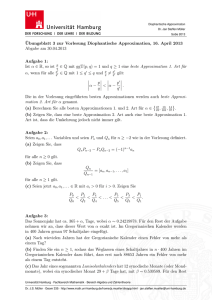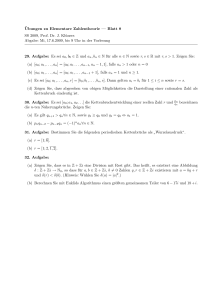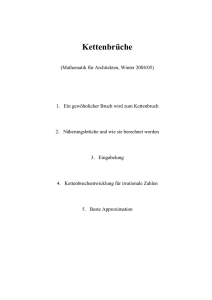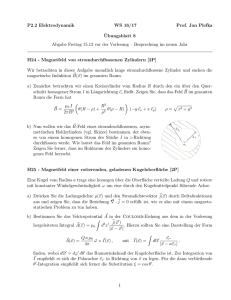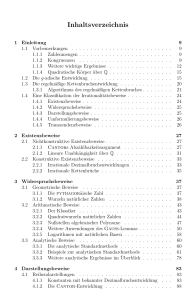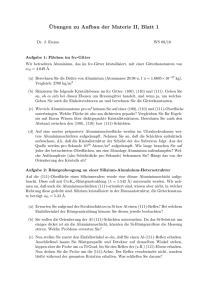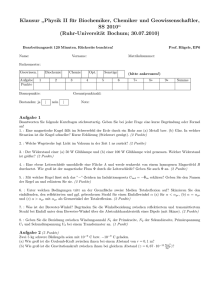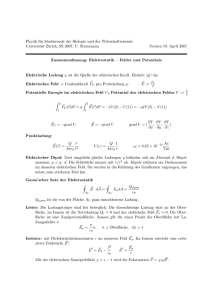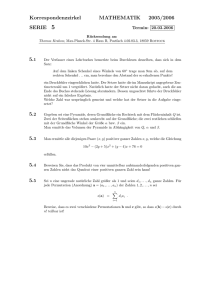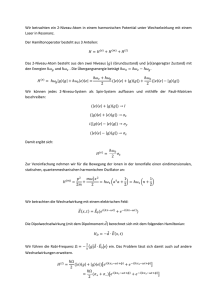Kettenbrüche und Approximation
Werbung
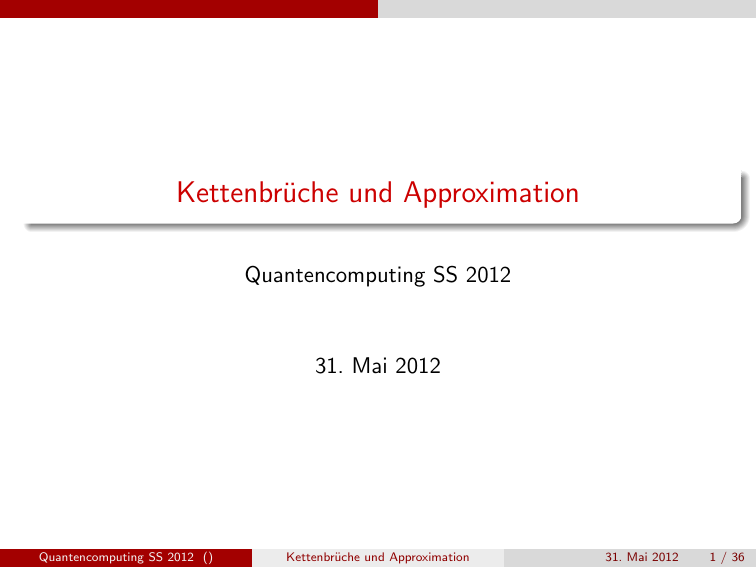
Kettenbrüche und Approximation
Quantencomputing SS 2012
31. Mai 2012
Quantencomputing SS 2012 ()
Kettenbrüche und Approximation
31. Mai 2012
1 / 36
Outline
1
Euklidischer Algorithmus
2
Kettenbruchdarstellung reeller Zahlen
3
Kontinuanten
4
Gute und vorzügliche Approximationen
5
Periodische Zustände und rationale Approximation
Quantencomputing SS 2012 ()
Kettenbrüche und Approximation
31. Mai 2012
2 / 36
Euklidischer Algorithmus
Euklidischer Algorithmus
. Der euklidische Algorithmus für (a0 , a1 ) = (a, b) mit a, b ∈ N>0 :
a0 = a1 · q1 + a2
(0 < a2 < a1 )
a1 = a2 · q2 + a3
..
.
(0 < a3 < a2 )
an−2 = an−1 · qn−1 + an
(0 < an < an−1 )
an−1 = an · qn
liefert eine Quotientenfolge (q1 , q2 , . . . , qn−1 , qn )
mit q1 ≥ 0, q2 , . . . , qn−1 ≥ 1, qn ≥ 2
. Es ist an = ggT(a, b). In erweiterter Form (EEA) kann man s, t ∈ Z
berechnen mit s · a + t · b = ggT(a, b) (Bézout-Beziehung)
Quantencomputing SS 2012 ()
Kettenbrüche und Approximation
31. Mai 2012
3 / 36
Euklidischer Algorithmus
andere Sicht des euklidischen Algorithmus
. Divisionsfolge
a0
a2
= q1 + ,
a1
a1
a1
a3
= q2 + ,
a2
a2
a2
a4
= q3 +
...
a3
a3
. Durch Einsetzen entsteht
a0
a2
1
= q1 +
= q1 +
a1
a1
a1 /a2
1
= q1 +
= q1 +
q2 + a3 /a2
= q1 +
Quantencomputing SS 2012 ()
1
1
q2 +
q3 + a4 /a3
Kettenbrüche und Approximation
1
q2 +
1
a2 /a3
= ...
31. Mai 2012
4 / 36
Euklidischer Algorithmus
Einfache Kettenbrüche
. Aus der Quotientenfolge des EA ergibt sich die Kettenbruchdarstellung der
a
rationalen Zahl :
b
1
a
=: hq1 , q2 , . . . , qn i
= q1 +
b
1
q2 +
1
q3 +
1
..
.+
qn
. Für 1 ≤ ` ≤ n sind die rationalen Zahlen
hai
1
= hq1 , q2 , . . . , q` i
= q1 +
b `
1
q2 +
1
q3 +
1
..
.+
q`
a
die Näherungsbrüche von .
b
Quantencomputing SS 2012 ()
Kettenbrüche und Approximation
31. Mai 2012
5 / 36
Euklidischer Algorithmus
Beispiel
. Der euklidische Algorithmus für a = 57, b = 33 liefert
57 = 33 · 1 + 24
33 = 24 · 1 + 9
24 = 9 · 2 + 6
9=6·1+3
6=3·2
. Der Quotientenfolge (1, 1, 2, 1, 2) entspricht der endliche Kettenbruch
57
=1+
33
1
= h1, 1, 2, 1, 2i
1
1+
2+
1
1+
Quantencomputing SS 2012 ()
1
2
Kettenbrüche und Approximation
31. Mai 2012
6 / 36
Euklidischer Algorithmus
Beispiel (Forts.)
. Die Näherungsbrüche sind
57
= h1i = 1
33
1
57
7
= h1, 1, 2, 1i =
33 4
4
. Beachte
1<
57
57
5
= h1, 1i = 2
= h1, 1, 2i =
33 2
33 3
3
57
19
= h1, 1, 2, 1, 2i =
33 5
11
19
57
7
5
<
=
< <2
3
11
33
4
. sowie
19 5 − = 2 < 1
11 3 33
32
Quantencomputing SS 2012 ()
19 7 − = 1 < 1
11 4 44
42
Kettenbrüche und Approximation
31. Mai 2012
7 / 36
Euklidischer Algorithmus
Beispiel
. Bei Aristarch (310-230 v-Chr.) findet sich die Approximation
71 755 875
43
≈
61 735 500
37
. Beachte
71 755 875
43
= 1.162311393 . . . und
= 1.162162162 . . .
61 735 500
37
. Tatsächlich ist
43
= h1, 6, 6i
37
ein Näherungsbruch von
71 755 875
= h1, 6, 6, 4, 1, 2, 1, 2, 1, 6i
61 735 500
Quantencomputing SS 2012 ()
Kettenbrüche und Approximation
31. Mai 2012
8 / 36
Kettenbruchdarstellung reeller Zahlen
Kettenbruchdarstellung reeller Zahlen
. Das Prinzip der Kettenbruchentwicklung kann auf beliebige reelle
Zahlen übetragen werden: ξ ∈ R kann (eindeutig) zerlegt werden in
ξ = q1 + {ξ}
. Falls {ξ} =
6 0, setze
ξ0
ξ 0 = q2 + {ξ 0 }
wobei q1 = bξc ∈ Z und 0 ≤ {ξ} < 1
= 1/{ξ} ∈ R>1 , dann gilt:
wobei q2 = bξ 0 c ∈ N≥1 und 0 ≤ {ξ 0 } < 1
. Zusammen ergibt das
ξ = q1 +
1
q2 + {ξ 0 }
. und analog mit ξ 00 = 1/{ξ 0 }, falls {ξ 0 } =
6 0:
1
ξ = q1 +
q2 +
1
q3 + {ξ 00 }
. u.s.w.
Quantencomputing SS 2012 ()
Kettenbrüche und Approximation
31. Mai 2012
9 / 36
Kettenbruchdarstellung reeller Zahlen
Eigenschaften der Kettenbruchentwicklung
. Für ξ ∈ R wird eine endliche oder unendliche “Quotientenfolge”
(q1 , q2 , q3 , . . .) von ganzen Zahlen (q1 ∈ Z, q` ∈ N≥1 für ` > 1) erzeugt mit
1
ξ = q1 +
q2 +
=: hq1 , q2 , q3 , . . .i
1
q3 +
1
..
.
. Die Folge bricht genau dann nach endlich-vielen Schritten ab, d.h.
ξ = hq1 , q2 , q3 , . . . , qn i,
wenn ξ rational ist
. Die Folge wird genau dann schliesslich-periodisch (d.h. periodisch nach
einem endlichen Anfangsstück), wenn ξ nicht rational ist, aber einer
Gleichung 2. Grades genügt (“quadratische Irrationalität”)
Quantencomputing SS 2012 ()
Kettenbrüche und Approximation
31. Mai 2012
10 / 36
Kettenbruchdarstellung reeller Zahlen
. Die “Näherungsbrüche”
1
[ξ]` = q1 +
q2 +
= hq1 , q2 , . . . , q` i (` = 1, 2, . . .)
1
..
.+
1
q`
sind sehr gute rationale Approximationen von ξ!
Quantencomputing SS 2012 ()
Kettenbrüche und Approximation
31. Mai 2012
11 / 36
Kettenbruchdarstellung reeller Zahlen
Beispiele
. Goldener Schnitt
√
1+ 5
= h1, 1, 1, 1, . . .i
φ=
2
. mit den Näherungsbrüchen
([φ]` )`≥1
2 3 5 8 13
= 1, , , , , , . . .
1 2 3 5 8
(Quotienten aufeinanderfolgender Fibonacci-Zahlen)
. Beachte
1<
Quantencomputing SS 2012 ()
3
8
13
5
2
< < ... < φ < ... <
< <
2
5
8
3
1
Kettenbrüche und Approximation
31. Mai 2012
12 / 36
Kettenbruchdarstellung reeller Zahlen
Beispiele
. Beispiel
√
7
√
7 = h2, 1, 1, 1, 4, 1, 1, 1, 4, 1, 1, 1, 4, 1, 1, 1 . . .i
. mit den Näherungsbrüchen
h√ i 7
` `≥1
=
5 8 37 45 82 127 590 717 1307
2, 3, , , , , ,
,
,
,
,...
2 3 14 17 31 48 223 271 494
. Beachte
2<
√
5
37
82
127
45
8
<
<
< ... < 7 < ... <
<
< <3
2
14
31
48
17
3
. Beispiele für die Approximationsgüte
√
√
7 − 82 = 0.000590021 . . . ,
7 − 1307 = 0.000002323 . . .
31
494 Quantencomputing SS 2012 ()
Kettenbrüche und Approximation
31. Mai 2012
13 / 36
Kettenbruchdarstellung reeller Zahlen
Beispiele
. Beispiel
√
3
3
√
3
3 = h1, 2, 3, 1, 4, 1, 5, 1, 1, 6, 2, 5, 8, 3, 3, 4, . . .i
. mit den Näherungsbrüchen
h√ i 3
3
` `≥1
3 10 13 62 75 437 512 949 6206 13361
= 1, , , , , ,
,
,
,
,
,...
2 7 9 43 52 303 355 658 4303 9264
. Beispiele für die Approximationsgüte
√
√
3 3 − 949 = 0.000000330 . . .
3 3 − 62 = 0.000389105 . . . ,
43
658 Quantencomputing SS 2012 ()
Kettenbrüche und Approximation
31. Mai 2012
14 / 36
Kettenbruchdarstellung reeller Zahlen
Beispiele
. Beispiel e
e = h2, 1, 2, 1, 1, 4, 1, 1, 6, 1, 1, 8, 1, 1, 10, 1, . . .i
. mit den Näherungsbrüchen
8 11 19 87 106 193 1264 1457 2721
([e] )`≥1 = 2, 3, , , , ,
,
,
,
,
,...
3 4 7 32 39 71 465 536 1001
. Beispiele für die Approximationsgüte
e − 87 = 0.000468172 . . . ,
32 Quantencomputing SS 2012 ()
e − 2721 ≈ 1.1 · 10−7
1001 Kettenbrüche und Approximation
31. Mai 2012
15 / 36
Kettenbruchdarstellung reeller Zahlen
Beispiele
. Beispiel π
π = h3, 7, 15, 1, 292, 1, 1, 1, 2, 1, 3, 1, 14, 2, 1, 1, . . .i
. mit den Näherungsbrüchen
22 333 355 103993 104348 208341 312689
([π] )`≥1 = 3, ,
,
,
,
,
,
,...
7 106 113 33102 33215 66317 99532
. Beispiele für die Approximationsgüte
π − 355 ≈ 2.66 · 10−7 ,
113 Quantencomputing SS 2012 ()
π − 103993 ≈ 10−9
33102 Kettenbrüche und Approximation
31. Mai 2012
16 / 36
Kontinuanten
Eulersche Polynome (alias Kontinuanten)
. Die Folge von Polynomen en (x1 , x2 , . . . , xn ) (n ≥ 0) wird induktiv
definiert durch
e0 () = 1
e1 (x1 ) = x1
en+1 (x1 , x2 , . . . , xn+1 ) =xn+1 · en (x1 , . . . , xn ) + en−1 (x1 , ..., xn−1 )
. Es gilt auch
en+1 (x1 , x2 , . . . , xn+1 ) = x1 · en (x2 , . . . , xn ) + en−1 (x3 , . . . , xn )
. Erste Werte
e2 (x1 , x2 ) = x1 x2 + 1, e3 (x1 , x2 , x3 ) = x1 x2 x3 + x1 + x3 ,
e4 (x1 , x2 , x3 , x4 ) = x1 x2 x3 x4 + x1 x2 + x1 x3 + x1 x4 + 1
. Die Werte en (1, 1, . . . , 1) sind Fibonacci-Zahlen
Quantencomputing SS 2012 ()
Kettenbrüche und Approximation
31. Mai 2012
17 / 36
Kontinuanten
Näherungsbrüche und eulersche Polynome
. Der Zusammenhang zwischen der Kettenbruchdarstellung und den
eulerschen Polynomen:
Erzeugt der euklidische Algorithmus für ξ ∈ R die Quotientenfolge
(q1 , q2 , . . . , qn , . . .), so gilt für die Näherungsbrüche
[ξ]` =
e` (q1 , q2 , . . . , q` )
e`−1 (q2 , q3 , . . . , q` )
. Beweis durch Induktion
[ξ]`+1 = hq1 , . . . , q` , q`+1 i = q1 +
1
hq2 , . . . , q` , q`+1 i
e`−1 (q3 , . . . , q`+2 )
e` (q2 , . . . , q`+2 )
q1 · e` (q2 , . . . , q`+2 ) + e`−1 (q3 , . . . , q`+2 )
=
e` (q2 , . . . , q`+2 )
e`+1 (q1 , . . . , q`+2 )
=
e` (q2 , . . . , q`+2 )
= q1 +
Quantencomputing SS 2012 ()
Kettenbrüche und Approximation
31. Mai 2012
18 / 36
Kontinuanten
. Es gilt also
e1 (q1 )
= q1
e0 ()
e2 (q1 , q2 )
q1 q2 + 1
[ξ]2 =
=
e1 (q2 )
q2
e3 (q1 , q2 , q3 )
q1 q2 q3 + q1 + q3
[ξ]3 =
=
e2 (q2 , q3 )
q2 q3 + 1
e4 (q1 , q2 , q3 , q4 )
q1 q2 q3 q4 + q1 q2 + q1 q3 + q1 q4 + 1
[ξ]4 =
=
e3 (q2 , q3 , q4 )
q1 q2 q3 + q1 + q3
[ξ]1 =
usf.
Quantencomputing SS 2012 ()
Kettenbrüche und Approximation
31. Mai 2012
19 / 36
Gute und vorzügliche Approximationen
Approximation durch Näherungsbrüche
. Es gilt für alle ` ≥ 1
e`+1 (x1 , . . . , x`+1 ) e` (x1 , . . . , x` )
det
= (−1)`−1
e` (x2 , . . . , x`+1 ) e`−1 (x2 , . . . , x` )
Beweis mittels Induktion
. Folgerung:
e`+1 (q1 , q2 , . . . , q`+1 )
e` (q1 , q2 , . . . , q` )
−
e` (q2 , q3 , . . . , q`+1 )
e`−1 (q2 , q3 , . . . , q` )
`−1
(−1)
=
e`−1 (q2 , q3 , . . . , q` )e` (q2 , q3 , . . . , q`+1 )
[ξ]`+1 − [ξ]` =
. und daran erkennt man das Schachtelungsverhalten:
[ξ]1 < [ξ]3 < [ξ]5 < . . . < [ξ]n = ξ < . . . < [ξ]6 < [ξ]4 < [ξ]2
Quantencomputing SS 2012 ()
Kettenbrüche und Approximation
31. Mai 2012
20 / 36
Gute und vorzügliche Approximationen
Approximation durch Näherungsbrüche (Forts.)
. Die Approximationgüte:
|[ξ]` − ξ| <
1
e`−1 (q2 , q3 , . . . , q` ) · e` (q2 , q3 , . . . , q`+1 )
. also auch
|[ξ]` − ξ| <
1
e`−1 (q2 , q3 , . . . , q` )2
. Beachte: e`−1 (q2 , q3 , . . . , q` ) ist der Nenner des `-ten
Näherungsbruches [ξ]`
Quantencomputing SS 2012 ()
Kettenbrüche und Approximation
31. Mai 2012
21 / 36
Gute und vorzügliche Approximationen
Rationale Approximation
. Ist ξ ∈ R, so heisst eine rationale Zahl
p
q
∈ Q mit ξ 6=
p
q
. eine gute Approximation von ξ, falls
ξ − p < 1
q q2
. eine vorzügliche Approximation von ξ, falls
ξ − p < 1
q 2q 2
. Obige Herleitung zeigt also
. Jeder Näherungsbruch [ξ]` einer reellen Zahl ξ ist eine gute
Approximation von ξ
. eine nicht-rationale reelle Zahl ξ ∈ R \ Q hat unendlich-viele gute
rationale Approximationen
. Es ist nicht schwer zu zeigen:
. eine rationale Zahl ξ ∈ Q hat nur endlich-viele gute rationale
Approximationen
Quantencomputing SS 2012 ()
Kettenbrüche und Approximation
31. Mai 2012
22 / 36
Gute und vorzügliche Approximationen
Rationale Approximation
. Theorem [Dirichlet]:
Ist eine rationale Zahl qp eine vorzügliche Approximation einer reellen
Zahl ξ, so tritt sie als einer der Näherungsbrüche der
Kettenbruchentwicklung von ξ auf, d.h. es ist
p
= [ξ]` für ein ` ≥ 1.
q
. Beweisskizze:
. Es sei
p
en (q1 , q2 , . . . , qn )
Pn
= hq1 , q2 , . . . , qn i =
=
q
en−1 (q2 , q3 , . . . , qn )
Qn
mit q1 , q2 , . . . , qn ∈ N≥1 .
. Für 1 ≤ λ < ∞ sei
1
ξλ = hq1 , q2 , . . . , qn−1 , qn + i
λ
Pn−1 · (qn + λ1 ) + Pn−2
λ Pn + Pn−1
=
=
λ Qn + Qn−1
Qn−1 · (qn + λ1 ) + Qn−2
Quantencomputing SS 2012 ()
Kettenbrüche und Approximation
31. Mai 2012
23 / 36
Gute und vorzügliche Approximationen
. Die Abbildung λ 7→ ξλ ist eine
Bijektion vom Intervall
streng-monotone
Pn Pn +Pn−1
(1, ∞) auf das Intervall In = Qn , Qn +Qn−1 bzw. auf das Intervall
+Pn−1 Pn
, je nachdem...
In = QPnn +Q
,
Q
n−1
n
Für alle ξ ∈ In gilt: die ersten n Näherungsbrüche von ξ stimmen mit
denen von hq1 , q2 , . . . , qn i überein:
[ξ]` =
P`
Q`
(1 ≤ ` ≤ n)
Die Länge des Intervalls In ist
Pn
Pn + Pn−1 1
1
|In | = −
=
≥ 2
Qn
Qn + Qn−1
Qn · (Qn + Qn−1 )
Qn
Pn
Pn vorzügliche Approximation von ξ, also ξ − Q
Ist Q
< Q12 so gilt
n
n
n
Pn
Pn
ξ ∈ In (wegen ξ ≥ Q
(bzw. ξ ≤ Q
, je nachdem ...)
n
n
Pn
Pn
und damit insbesondere [ξ]n = Qn , d.h. Q
ist Näherungsbruch von ξ. n
Quantencomputing SS 2012 ()
Kettenbrüche und Approximation
31. Mai 2012
24 / 36
Gute und vorzügliche Approximationen
.
. Ist ξ ∈ R und sind
ξ −
p
q
und
p 1
≤ 2,
q
2ρ
p0
q0
rationale Zahlen mit
0
ξ − p ≤ 1
q 0 2ρ2
und q, q 0 ≤ ρ,
(also insbesondere beides vorzügliche Approximationen von ξ), so gilt
p p 0 pq 0 − p 0 q 1
− =
q q 0 qq 0 ≤ ρ2
und das ist bis auf den banalen Fall q = q 0 = ρ = 1, p = p ± 1 nur
0
möglich, wenn qp = qp0 .
. Folgerung: Zu jedem ρ > 0 gilt
|ξ − [ξ]` | ≤
1
2ρ2
für höchstens einen der Näherungsbrüche [ξ]` mit Nenner ≤ ρ
Quantencomputing SS 2012 ()
Kettenbrüche und Approximation
31. Mai 2012
25 / 36
Gute und vorzügliche Approximationen
Aristarchs Beispiel
. Aristarchs Bruch
ξ=
71755875
21261
=
= h1, 6, 6, 4, 1, 2, 1, 2, 1, 6i
61735500
18292
. Näherungsbrüche
7 43 179 222 623 845 2313 3158 21261
([ξ]` )1≤`≤10 = 1, , ,
,
,
,
,
,
,
6 37 154 191 536 727 1990 2717 18292
. Die Näherungsbrüche für ` = 1, 2, 3, 5, 7, 9, 10 sind vorzüglich, die
anderen nicht. Beispielsweise:
1
2 · 1542
1
ξ − [ξ]5 = 0.00000772803 . . . < 0.00001370576 . . . =
2 · 1912
ξ − [ξ]4 = 0.00002626937 . . . > 0.00002108281 . . . =
Quantencomputing SS 2012 ()
Kettenbrüche und Approximation
31. Mai 2012
26 / 36
Gute und vorzügliche Approximationen
Aristarchs Beispiel (Forts.)
. Zum ρ-Kriterium
. Der Näherungsbruch [ξ]5 = 222
191 erfüllt das ρ-Kriterium
ξ − p ≤ 1 mit q ≤ ρ
q 2ρ2
für ρ = 191, . . . , 254, aber nicht mehr für ρ = 255, . . ..
. Der Näherungsbruch [ξ]6 = 623
536 kann das ρ-Kriterium überhaupt nicht
erfüllen, da er nicht vorzüglich ist.
. Der folgende vorzügliche Näherungsbruch [ξ]7 = 845
727 erfüllt das
ρ-Kriterium für ρ = 727, . . . , 974.
Quantencomputing SS 2012 ()
Kettenbrüche und Approximation
31. Mai 2012
27 / 36
Gute und vorzügliche Approximationen
Das Beispiel π
. Erste Näherungsbrüche von π:
22 333 355 103993 104348 208341
,
,
,
,
([π]` )1≤`≤7 = 3, ,
7 106 113 33102 33215 66317
. Davon sind die Näherungsbrüche [π]` für ` = 1, 2, 4, 6 vorzüglich, die
anderen nicht. Beispielsweise:
|π − [π]4 | = 2.6676 . . . · 10−7 < 3.9157 · · · 10−5 =
1
2 · 1132
|π − [π]5 | = 5.7789 . . . · 10−10 > 4.5631 . . . · 10−10 =
Quantencomputing SS 2012 ()
Kettenbrüche und Approximation
1
2 · 331022
31. Mai 2012
28 / 36
Gute und vorzügliche Approximationen
Das Beispiel π (Forts.)
. Zum ρ-Kriterium
. Der Näherungsbruch [π]4 = 355
113 erfüllt das ρ-Kriterium
π − p ≤ 1 mit q ≤ ρ
q 2ρ2
für ρ = 191, . . . , 1369, aber nicht mehr ab ρ = 1370.
. Der Näherungsbruch [π]5 = 103993
33102 kann das ρ-Kriterium überhaupt
nicht erfüllen, da er nicht vorzüglich ist.
. Der folgende vorzügliche Näherungsbruch [π]6 = 104348
33215 erfüllt das
ρ-Kriterium für ρ = 33215, . . . , 38829.
Quantencomputing SS 2012 ()
Kettenbrüche und Approximation
31. Mai 2012
29 / 36
Periodische Zustände und rationale Approximation
Periodische Zustände und rationale Approximation
. Sei jetzt wieder (mit N = 2n ≥ 2r 2 )
1
|φr ,b i = √
mb
X
|z · r + bi
0≤z·r +b<N
. QFT −1 |φr ,b i ist ein Zustand, bei dessen Messung man mit grosser
Wahrscheinlichkeit einen Basiszustand |y i mit 0 ≤ y < 2n erhält, für
den 2yn nahe bei einem ganzzahligen Vielfachen kr von 1r liegt.
Quantencomputing SS 2012 ()
Kettenbrüche und Approximation
31. Mai 2012
30 / 36
Periodische Zustände und rationale Approximation
Periodische Zustände und rationale Approximation
. (gleiche Bezeichnungen wie vorher)
. Es gilt
y
− k ≤ 1
2n
r 2r 2
=⇒ p(y ) ≥
4mb
4
≈ 2
2
n
π 2
π r
. Ein solches k/r ist vorzügliche Approximation von y /2n .
hy i
. Deshalb ist k/r ein Näherungsbruch n .
2 `
. k/r erfüllt das ρ-Kriterium mit ρ = 2(n−1)/2 . Deshalb ist k/r der einzige
hy i
Näherungsbruch n mit einem Nenner ≤ ρ = 2(n−1)/2 und
2 `
y
hy i
1
n − n ≤ 2.
2
2 `
2ρ
. Man erhält k/r durch Inspektion der Näherungsbrüche.
Aber: k und r müssen nicht teilerfremd sein!
Quantencomputing SS 2012 ()
Kettenbrüche und Approximation
31. Mai 2012
31 / 36
Periodische Zustände und rationale Approximation
Beispiel
. r = 11, n = 9, N = 512 = 29 , ρ = 24
. Untersuche potentielle Messergebnisse y mit
k·N
r
y
N
≈
k
11
für k = 6:
6·512
11
. es ist
=
= 297.27
. deshalb wird man für y = 297 und y = 280 Erfolg haben
. in der Tat hat
297
= h0, 1, 1, 5, 15, 3i
512
die Näherungsbrüche [0, 1, 1/2, 6/11, 91/167, 279/512], von denen alle
6
ausser dem ersten vorzügliche Approximationen sind und 11
das
ρ-Kriterium mit ρ = 24 erfüllt.
. Damit weiss man, dass das gesuchte r ein Vielfaches von 11 sein muss.
. Mit y = 280 hat man
280
= h0, 1, 1, 4, 1, 5i
512
mit den Näherungsbrüchen [0, 1, 1/2, 5/9, 6/11, 35/64] von denen
6
wiederum 11
der einzige ist, das ρ-Kriterium mit ρ = 24 erfüllt
Quantencomputing SS 2012 ()
Kettenbrüche und Approximation
31. Mai 2012
32 / 36
Periodische Zustände und rationale Approximation
Beispiel (Forts.)
. r = 11, n = 9, N = 512 = 29 , ρ = 24 und k = 6
. Was geschieht bei Messwerten y = 278 und y = 281?
. Für y = 278 ist
278
= h0, 1, 1, 5, 3, 7i.
512
Die Näherungsbrüche 0, 1, 1/2, 6/11, 19/35, 139/256 sind bis auf den
ersten alle vorzüglich, aber keiner erfüllt das ρ-Kriterium mit ρ = 24 .
. Für y = 281 ist
281
= h0, 1, 1, 4, 1, 1, 1, 1, 1, 2, 2i.
512
Die Näherungsbrüche
0, 1, 1/2, 5/9, 6/11, 11/20, 17/31, 28/51, 45/82, 118/215, 281/512 sind
bis auf den ersten und den vierten alle vorzüglich, aber keiner erfüllt
das ρ-Kriterium mit ρ = 24 .
Quantencomputing SS 2012 ()
Kettenbrüche und Approximation
31. Mai 2012
33 / 36
Periodische Zustände und rationale Approximation
Beispiel
. r = 12, n = 9, N = 512 = 29 , ρ = 24
. Untersuche potentielle Messergebnisse y mit
k·N
r
y
N
≈
k
11
für k = 7:
7·512
12
=
= 298.6
. es ist
. brauchbare Resultate sind für y = 298 und y = 299 zu erwarten
. 298/512 = h0, 1, 1, 2, 1, 1, 4, 1, 3i hat Näherungsbrüche
7
0, 1, 1/2, 3/5, 4/7, 7/12, 32/55, 39/67, 149/256 von denen 12
das
4
ρ-Kriterium mit ρ = 2 erfüllt.
. 299/512 = h0, 1, 1, 2, 2, 10, 4i Näherungsbrüche
7
0, 1, 1/2, 3/5, 7/12, 73/125, 299/512 von denen 12
das ρ-Kriterium mit
4
ρ=2
. y = 297 und y = 300 (beispielsweise) liefern keine Information
Quantencomputing SS 2012 ()
Kettenbrüche und Approximation
31. Mai 2012
34 / 36
Periodische Zustände und rationale Approximation
Beispiel
. r = 12, n = 9, N = 512 = 29 , ρ = 24
. Untersuche potentielle Messergebnisse y mit
k·N
r
y
N
≈
k
11
für k = 8:
8·512
12
. es ist
=
= 341.3
. brauchbare Resultate sind für y = 341 und y = 342 zu erwarten
. 341/512 = h0, 1, 1, 1, 170i hat Näherungsbrüche 0, 1, 1/2, 2/3, 341/512
von denen 23 das ρ-Kriterium mit ρ = 24 erfüllt.
. 342/512 = h0, 1, 2, 85i Näherungsbrüche 0, 1, 2/3, 171/256 von denen
2
4
3 das ρ-Kriterium mit ρ = 2
. y = 340 und y = 343 (beispielsweise) liefern keine Information
Quantencomputing SS 2012 ()
Kettenbrüche und Approximation
31. Mai 2012
35 / 36
Periodische Zustände und rationale Approximation
Beispiel
. r = 12, n = 9, N = 512 = 29 , ρ = 24
. Untersuche potentielle Messergebnisse y mit
k·N
r
y
N
≈
k
11
für k = 9:
9·512
12
=
= 384
. es ist
. Dies ist eine spezielle Situation: k·N
r ist eine ganze Zahl!
. Für y = 384 ist 384/512 = 3/4 = h0, 1, 3i hat man die
Näherungsbrüche 0, 1, 3/4, von denen 43 das ρ-Kriterium mit ρ = 24
erfüllt.
. Für y = 383 und y = 385 (beispielsweise) erhält man keinerlei
Information.
. Aus dem Fall k = 8 sieht man, dass das gesuchte r ein Vielfaches von
3 sein muss; wegen Fall k = 9 muss es ein Vielfaches von 4 sein,
insgesamt also ein Vielfaches von 12 (was sich auch aus Fall k = 7
ergeben hatte)
Quantencomputing SS 2012 ()
Kettenbrüche und Approximation
31. Mai 2012
36 / 36
